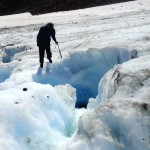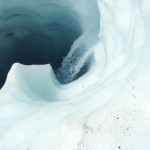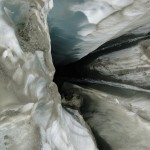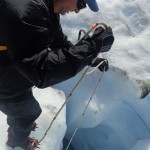September 1, 2016
Moulins: Clarifying Impacts on Glacier Velocity
Posted by Mauri Pelto
In the last week I have read three separate articles referring to glacier moulins as lubricating the bed of a glacier resulting in overall velocity increase, for example EOS (Aug. 2016), this is not generally accurate. Having spent considerable time observing moulins and reviewing some excellent studies that indicate their impact, it is worth noting again a more complete picture of the role moulins play. This is a role that warrants considerable further examination. In 2008 and 2011 I wrote a piece indicating why this a generalization that is only sometimes accurate. The key to increasing glacier velocity is high basal water pressure, not simply lots of meltwater. Think of your car, if you have low oil pressure that is an issue for efficient running. If you have high oil pressure that is ideal. If you have high oil pressure and you add more oil that does not further lubricate the engine. Delivering more water to the base of a glacier that already has lots of meltwater drainage will not typically lead to a significant acceleration. A number of studies since 2008 have better illustrated this principle as it applies to ice sheets.
Ahlstrøm et al (2013) examined 17 Greenland glaciers and noted a pattern, “Common to all the observed glacier velocity records is a pronounced seasonal variation, with an early melt season maximum generally followed by a rapid mid-melt season deceleration”. This indicates the Greenland glaciers are more like a typical alpine glacier and are susceptible to the forces that tend to cause alpine glaciers to experience peak flow during spring and early summer. Those forces are the delivery of meltwater to the base of the glacier, when a basal conduit system is poorly developed. This leads to high basal water pressure, which enhances sliding. As the conduit system develops/evolves the basal water pressure declines as does basal sliding, even with more meltwater runoff.
This is what has been reported to be the case by Sundal et al (2011) in Greenland. They found a similar early season velocity in all years, with a reduced velocity late in summer during the warmest years. This suggested that a more efficient melt drainage system had developed, reducing basal water pressure for a longer period of time. The meltwater lubrication mechanism is real, but as observed is limited both in time and area impacted. It is likely that, as on alpine glaciers, the seasonal speedup is offset by a greater slowdown late in the melt season. Most observed acceleration due to high meltwater input has been on the order of several weeks, leading to a 10-20% flow increase for that period.
Moon et al (2014) examined 55 Greenland glaciers and found three distinct seasonal velocity patterns. Type 1 behavior is characterized by speedup between late spring and early summer with speed remaining high until late winter or early spring, with the principal sensitivity being to terminus conditions and position. Type 2 behavior has stable velocity from late summer through spring, with a strong early summer speedup as runoff increases and midsummer slowing, as the glacier develops an efficient drainage system. Type 3 behavior has a mid-summer slowdown leading to a pronounced late summer minimum during the period of maximum runoff. Velocity than rebounds over the winter. The common behavior is then a slowdown during periods of peak runoff and moulin drainage.
Anderson et al (2011) noted that changes in velocity due to a 45% change in meltwater input were small 4-5% on Helheim Glacier.
Clason et al (2015) modelled development of moulins and their ability to deliver the water to the bed of Leverett Glacier. This study illustrates the level of details that is being examined to better model meltwater routing, which will inform flow models as noted by EOS (2015).
Moulins increase meltwater flow to a glacier bed. In areas where significant surface melt occurs, this tends to lead to an early melt season increase in basal water pressure and then velocity. This is typically followed by a mid/late melt season deceleration with continued meltwater drainage through moulins. The lubrication is hence, restricted in time, and if followed by a deceleration, does not necessarily lead to an increase in the overall glacier velocity. Certainly in some cases moulins will increase overall velocity and in others not.
- Moulin on Rainbow Glacier
- Moulin on Rainbow Glacier
- Moulin on Columbia Glacier
- Moulin on Columbia Glacier
- Filming Moulin







 Dean of Academic Affairs at Nichols College and Professor of Environmental Science at Nichols College in Massachusetts since 1989. Glaciologist directing the North Cascade Glacier Climate Project since 1984. This project monitors the mass balance and behavior of more glaciers than any other in North America.
Dean of Academic Affairs at Nichols College and Professor of Environmental Science at Nichols College in Massachusetts since 1989. Glaciologist directing the North Cascade Glacier Climate Project since 1984. This project monitors the mass balance and behavior of more glaciers than any other in North America.